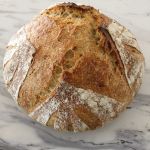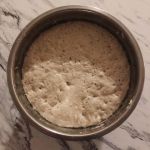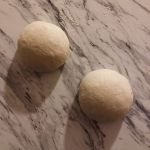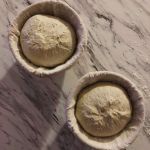Whew does it ever feel good to be back! It’s been a long 10 months since I posted anything here. Becoming a Mom last year completely changed my life. It has been one of the most amazing and rewarding experiences I’ve ever had, but my patience has been tested at every turn and a blindingly bright light shone into all the dark places of myself I didn’t what to look at. It’s been a long road and although I did do some baking here and there, it wasn’t until much more recently that I’ve felt any desire to create something new.
Then of course there’s the pandemic, but I’m so tired of hearing about it, thinking about it and worrying about it all the time. So, let’s just skip that part shall we?
The thought of tackling bread again seemed pretty daunting. Sourdough was out the window not only because my starter had grown moldy and forgotten in the back of the fridge, but taking care of another living being was (and still is) way beyond my capacity. So I went back to basics, pulled out my copy of Bread Baking for Beginners by Bonnie Ohara and got down to it. No spelt flour, no sourdough, just easy, simple recipes that I knew would produce excellent results as long as I followed them.
I made pizza dough every Friday for two months until my hubby and I got sick of eating pizza (who knew that was even possible?!). I made ficelles (rustic baguettes) and shared them with family. I went fancy and made cinnamon swirl raisin bread, with brioche dough, at Christmastime. Yowza that one was good. Finally, I circled back to bread, starting with the simplest no knead bread, then to the one that rises for most of the day and finally to the one that rises all night. My hands got sticky with bread dough, my nose filled with the smell of the dough baking to a golden hue and my heart fluttered with joy seeing the finished loaf, cutting through the crackling crust and ripping off a big piece of still warm bread with my teeth. Like a warm hug, I finally felt back in the embrace of my baker self… and it felt good.
Now, on to this spelt, einkorn and rye country bread! This is my take on a multigrain country loaf from Bonnie’s book. If you want to learn how to make amazing bread I highly recommend it. I’ve learned a lot even though I might not consider myself a beginner. 😉
This version of mine swaps the regular flour for spelt flour and the whole wheat flour for whole grain einkorn flour (whole spelt flour would work too). With a little munchkin around I also extended the rise time by cutting the yeast way back so I could start this dough in the evening after she’s gone to bed and finish it in the morning while juggling breakfast, keeping her away from the hot oven and putting her down for a nap (but hey, multi-tasking is what moms do right?). This is why you will see some of the progress photos are taken in the dark. Extending the rise time also improves the flavour of the bread, which is always a good thing!
After these loaves had cooled and my little one was up from her nap I cut some up for lunch and she happily dug in. Mind you, she eats any and all kinds of bread I’ve offered her. Like mother, like daughter I guess!
Happy baking!

If you liked this recipe you are going to love these ones!
No Knead Sourdough Rye Bread
Seedy Spelt Bread
Spelt Flour No Knead Bread

Spelt, Einkorn and Rye Country Bread
Ingredients
- 850 grams organic all purpose, unbleached spelt flour also called white spelt flour
- 100 grams whole grain einkorn flour
- 50 grams whole grain rye flour
- 20 grams sea salt
- 1/4 tsp instant yeast
- 620 grams water slightly warmer than room temperature (80F)
Instructions
-
Using two large glass measuring cups or pitchers, fill one 1/4 of the way with hot tap water and the other with cold tap water. Hold a thermometer in the pitcher with hot water and pour the cold water into the hot water until the thermometer reads 80 degrees F. Using a kitchen scale, weigh out the required water in a large bowl. Add the instant yeast to the water and give it a quick swirl with your finger.
(Note: I am assuming a room temperature of 70 degrees F here. If your room temperature is higher you will need slightly cooler water, if you room temperature is lower you will need slightly warmer water.)
-
Weigh the spelt, einkorn and rye flour in a medium bowl and whisk or mix with your hands to combine. Add the flours on top of the water and yeast. Finally, add the salt on top of the flour. Mix the dough together with your hands until evenly combined. Cover with a kitchen towel and let the dough rest for 30 minutes so the flour can absorb the water.

-
Lightly flour your work surface and scrape the dough out on to it. Gently knead the dough for a couple of minutes until it has tightened up and feels smooth. Place the dough back in the bowl and cover with plastic wrap, beeswax wrap, a large dinner plate or something else that will keep the moisture from escaping and the top of the dough from drying out.

-
Let the dough rise on the counter for 12 hours or until it has doubled in size and the surface is dotted with bubbles.

-
Lightly flour your work surface again and scrape the dough on to it. Using a metal dough scraper or large knife, divide the dough into two equal pieces. Fold the dough over onto itself and turn it over. Round the dough by sliding the dough scraper or your hands underneath the far side of it and gently pulling it towards you. Give it a quarter turn and repeat this process all around the dough until you have a nice tightened round. If the dough is not catching as you pull, scrape away some of the flour on your work surface and try again. Repeat with the other piece of dough. Dust each with flour and cover with a kitchen towel. Let rest for 30 minutes.

-
Lightly flour your work surface. Working with one dough at a time, turn it over so the smooth side is facing down. Fold the dough like a letter, bringing one side of the dough into the middle and then the other side on top. Turn and fold the dough this way in the other direction then turn it over so the seams are facing down. Round the dough by sliding a dough scraper or your hands underneath the far side of it and gently pulling it towards you. Give it a quarter turn and repeat this process all around the dough until you have a nice tightened round. If the dough is not catching as you pull, scrape away some of the flour on your work surface and try again. Repeat with the other piece of dough. Place each dough round into a floured proofing basket (or a bowl lined with a floured kitchen towel) seam side up. Cover both lightly with plastic wrap or a plastic produce bag cut open (if you have it). Let rise for one hour.

-
While the dough is rising, place two dutch ovens, including the lids, into the oven and pre-heat to 500 degrees F (or as high as your oven will go). Position the rack in the lower third of the oven. (Note: if you only have one dutch oven you will bake the loaves back to back instead of at the same time). To test if the dough is ready, press, do not poke, the tip of one wet finger quickly and lightly, about half an inch, slightly off center, into the crown of the dough (area of maximum expansion). If the indentation remains but springs back just slightly, the dough is ready to bake. If the dent fills in, give the dough another 5-10 minutes to rise and re-test.

-
Remove the plastic covering from your dough. Generously flour your work surface and tip both doughs (or just one if you are baking them back to back) onto it with the seam sides down. Remove the hot dutch ovens and place the lids beside them. With a lame or razor blade score the doughs with two deep slashes in the shape of a X (or another pattern). Pick them up one at a time and very carefully lower them into the dutch ovens. Replace the lids, slide them into the oven, lower the temperature to 475 degrees F and bake for 25 minutes.

-
After 25 minutes remove the lids and continue baking for another 15 to 20 minutes until the loaves are a deep chestnut colour. Remove from the oven and use pot holders to carefully lift the breads out and place them on a rack to cool thoroughly. If you have an instant read thermometer, the breads are done when the internal temperature is 190-200 degrees F.




If I don’t have einkorn, should I use more rye? more spelt?
Also, please come back to the blog!!!
Hi Sara,
I would use more spelt instead of einkorn. Spelt and einkorn are similar in gluten structure, whereas rye is quite different.
Happy baking!
Sophie
Whoops! Meant to also say that I’m still here. I’ve been baking away with my current recipes for the better part of a year now, tinkering with them. I’ve got a few new recipes to post soon!
Hello! I have whole wheat einkorn flour, is that okay to use!?
Hi April, yes absolutely. I should have specified in the recipe that I also used whole einkorn flour. You could also substitute whole wheat or whole spelt flour instead. Happy baking!
Could I make this a sourdough recipe? What would change about it? We can’t have instant yeast 🙁 thank you!
Hi there! I haven’t tried it specifically with this recipe, but you could omit the yeast and replace it with 300g or so of 100% hydration (half water, half flour) sourdough starter per loaf. It would create a slightly larger loaf but should still fit fine in the dutch oven. I have a very comprehensive sourdough miche/country bread recipe that I’m working on right now, am hoping to have it ready to go with videos and all very soon. Happy baking!
Hello,
I just found your recipe for Spelt and Einkorn bread with rye.
What if I don’t have rye flour and I just use more of the two flours I have on hand and omit the rye?
Thank you.
Hi there, it should work to omit the rye and substitute with more of the other two flours. I haven’t tried it though.